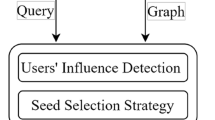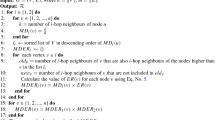Abstract
Influence maximization deals with the problem of identifying k-size subset of nodes in a social network that can maximize the influence spread in the network. In this paper, the problem of influence maximization using two aspects, node connectivity and node activity level, has been studied. To measure node connectivity, the widely popular and intuitive measure of out-degree of node has been used, and for node activity, node’s past interactions have been taken into consideration. For studying influence spread, two activity-based diffusion models, namely Activity-based Independent Cascade model and Activity-based Linear Threshold model, have been proposed in which influence propagation is driven by a node’s activity that it has actually performed in the past. Activity-based models aim at studying influence spread by incorporating a more realistic aspect corresponding to user behavior. Motivated by the belief that activity is as important as connectivity, UAC-Rank algorithm for the identification of initial adopters has been proposed.





Similar content being viewed by others
References
Agarwal S, Mehta S (2018) Social influence maximization using genetic algorithm with dynamic probabilities. In: 2018 eleventh international conference on contemporary computing (IC3). https://doi.org/10.1109/ic3.2018.8530626
Alshahrani M, Fuxi Z, Sameh A, Mekouar S, Huang (2018) Top-K influential users selection based on combined Katz centrality and propagation probability. In: IEEE 3rd international conference on cloud computing and big data analysis (ICCCBDA), pp 52–56
Chen W, Wang Y, Yang S (2009) Efficient influence maximization in social networks. In: 15th ACM SIGKDD international conference on knowledge discovery and data mining—KDD’09, pp 199–208
Deng X, Pan Y, Wu Y, Gui J (2015) Credit distribution and influence maximization in online social networks using node features. In: 12th international conference on fuzzy systems and knowledge discovery (FSKD), pp 2093–2100
Domingos P, Richardson M (2001) Mining the network value of customers. In: Seventh ACM SIGKDD international conference on knowledge discovery and data mining—KDD’01, pp 57–66
Goyal A, Bonchi F, Lakshmanan LVS (2011) A data-based approach to social influence maximization. Proc VLDB Endow 5(1):73–84
Heidemann J, Klier M, Probst F (2010) Identifying key users in online social networks: a PageRank based approach. In: 31st international conference on information systems (ICIS), pp 1–22
Jianqiang Z, Xiaolin G, Feng T (2017) A new method of identifying influential users in the micro-blog networks. IEEE Access 5:3008–3015
Kempe D, Kleinberg J, Tardos É (2003) Maximizing the spread of influence through a social network. In: 9th ACM SIGKDD international conference on knowledge discovery and data mining, KDD’03, pp 137–146
Kleinberg JM (1999) Authoritative sources in a hyperlinked environment. J ACM 46(5):604–632
Kurka DB, Godoy A, Von Zuben FJ (2016) Online social network analysis: a survey of research applications in computer science. arXiv:1504.05655v2
Liu D, Jing Y, Zhao J, Wang W, Song G (2017) A fast and efficient algorithm for mining top-k nodes in complex networks. Sci Rep 7:43330
Morone F, Makse HA (2015) Influence maximization in complex networks through optimal percolation. Nature 524(7563):65–68
Page L, Brin S, Motwani R, Winograd T (1998) The PageRank citation ranking: bringing order to the web. Technical report, Stanford InfoLab
Peng S, Wang G, Xie D (2017) Social influence analysis in social networking big data: opportunities and challenges. IEEE Netw 31(1):11–17
Peng S, Zhou Y, Cao L, Yu S, Niu J, Jia W (2018) Influence analysis in social networks: a survey. J Netw Comput Appl 106:17–32
Riquelme F, Gonzalez-Cantergiani P, Molinero X, Serna M (2018) Centrality measure in social networks based on linear threshold model. Knowl Based Syst 140:92–102
Sheng K, Zhang Z (2018) Research on the influence maximization based on community detection. In: 13th IEEE conference on industrial electronics and applications (ICIEA). https://doi.org/10.1109/iciea.2018.8398185
Tong G, Wu W, Tang S, Du DZ (2017) Adaptive influence maximization in dynamic social networks. IEEE/ACM Trans Netw 25(1):112–125
Wang Y, Zhang B, Vasilakos AV, Ma J (2014) PRDiscount: a heuristic scheme of initial seeds selection for diffusion maximization in social networks. Springer, Cham, pp 149–161
Zhu J, Liu Y, Yin X (2017) A new structure-hole-based algorithm for influence maximization in large online social networks. IEEE Access 5:23405–23412
Author information
Authors and Affiliations
Corresponding author
Additional information
Publisher's Note
Springer Nature remains neutral with regard to jurisdictional claims in published maps and institutional affiliations.
Rights and permissions
About this article
Cite this article
Saxena, B., Kumar, P. A node activity and connectivity-based model for influence maximization in social networks. Soc. Netw. Anal. Min. 9, 40 (2019). https://doi.org/10.1007/s13278-019-0586-6
Received:
Revised:
Accepted:
Published:
DOI: https://doi.org/10.1007/s13278-019-0586-6




